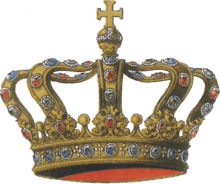Hoop crown


A hoop crown (German: Bügelkrone or Spangenkrone,[2] Latin: faislum),[3] arched crown, or closed crown, is a crown consisting of a "band around the temples and one or two bands over the head".[4] First used by the Carolingian dynasty,[5] hoop crowns became increasingly popular among royal dynasties in the Late Middle Ages,[6] and the dominant type of crown in the Modern Era.[7]
Origins
Hoop crowns were introduced to Germanic Europe by the Carolingian dynasty,[5] who usurped the throne of the Frankish Empire from the Merovingian dynasty in 751. However their use dates back to the end of the Roman Empire and the Byzantine Empire.[8] The Carolingian hoop crown was most probably[3] derived from the contemporary Germanic hoop helmet (German: Spangenhelm).[5] The oldest such crown is the Crown of Saint Faith in Conques, worn either by Pepin I (797–838) or Pepin II (823–864) of Aquitaine.[3] Other Carolingians known to have worn hoop crowns are Louis II "the German" (806–876), Charles II "the Bald" (823–877) and Odo of Vermandois (910–946).[3] Charlemagne (742–814) possibly wore a hoop crown, although the obscurities of contemporary portraits, in particular on seals, mean that this cannot be stated with certainty.[9] Sometimes, the Carolingian hoop crowns were combined with a cap, worn beneath.[4]
Though hoop crowns were characteristic for Carolingian kings, there were several other types of crowns worn by the members of this dynasty.[4] For example, Charlemagne also wore a crown shaped like a collar with an attachment on the front side.[9] The features most Carolingian crowns had in common were "cap or bands over the head, edge-bands, and pendilia".[4] Some of the Carolingian crowns were imitations of contemporary Byzantine Imperial crowns,[4] which had the shape of a closed cap (kamelaukion).[3] In turn, Byzantine Emperor Justinian I "the Great" (483–565) had hoops attached to his crown to carry a cross above it, creating the prototype of later hoop crowns.[2]
Spread
Hoop crowns became popular in late medieval Europe.[6] The Holy Roman Imperial crown was a hoop crown.[6] Norman king William the Conqueror wore a hoop crown, and in the 12th century, the kings of Hungary amended their collar with two hoops.[6] In both cases, the object of adopting a hoop crown was not to appear to occupy a position of inferiority to the Holy Roman Emperor.[6] William's crown was modelled after the crown of emperor Otto I and similarly decorated with twelve types of gems.[10] In addition, William had sceptre and virga created, resembling the imperial insignia.[10]
However, not all late medieval crowns had hoops. For example, the 15th-century kings of France wore crowns of the lilly type, a collar decorated with four lilies.[7] The hoop crown became the prevalent type of crown in the Early Modern Age.[7]
See also
Sources
References
- ↑ Schulz (2010)
- 1 2 Hartmann online, entries "Spangenkrone, Bügelkrone"
- 1 2 3 4 5 Lohrmann (1973), p. 764
- 1 2 3 4 5 Kornbluth (1990), p. 61
- 1 2 3 Schramm (1956), p. 888
- 1 2 3 4 5 Schramm (1959), p. 562
- 1 2 3 Schramm (1959), p. 561
- ↑ Grierson, P. (1993). Catalogue of the Byzantine Coins in the Dumbarton Oaks Collection and in the Whittemore Collection, 2: Phocas to Theodosius III, 602-717. Universidad de Harvard. Estados Unidos.
- 1 2 RGA V (1984), p. 371
- 1 2 Schramm (1956), p. 756
Bibliography
- Beck, Heinrich; Jankuhn, Herbert; Ranke, Kurt; Wenskus, Reinhard, eds. (1984). "Diadem". RGA (Reallexikon der Germanischen Altertumskunde) (in German). 5 (2 ed.).
- Hartmann, Peter W., ed. (1996). "Spangenkrone, Bügelkrone". Kunstlexikon (in German). Beyars. ISBN 3-9500612-0-7. Retrieved 2010-02-05.
- Kornbluth, Genevra (1990). "The Seal of Lothar II. Model and Copy". Francia. Forschungen zur europäischen Geschichte. 1 (17). Retrieved 2010-02-05.
- Lohrmann, D. (1973). "Rezensionen. P. E. Schramm, Kaiser, Könige und Päpste. Gesammelte Aufsätze zur Geschichte des Mittelalters, Band 2, Stuttgart 1968". Francia. Forschungen zur europäischen Geschichte (in German) (1). Retrieved 2010-02-05.
- Schramm, Percy Ernst (1956). Herrschaftszeichen und Staatssymbolik. Beiträge zu ihrer Geschichte vom dritten bis zum sechzehnten Jahrhundert. Schriften der Monumenta Germaniae Historica, Volume 13 (in German). 3. Hierseman.
- Schramm, Percy Ernst (1959). "Die Bügelkrone, ein karolingisches Herrschaftszeichen. Mit einem Anhang: die Lobwörter decus imperii und spes imperii". In Wegener, Wilhelm. Festschrift für Karl Gottfried Hugelmann zum 80. Geburtstag am 26. September 1959 (in German). 2. Scienta Verlag. pp. 561–579.
- Schulz, Matthias (2010-01-25). "Schleifstein der Schande" (in German). Der Spiegel Online. Retrieved 5 February 2010.

